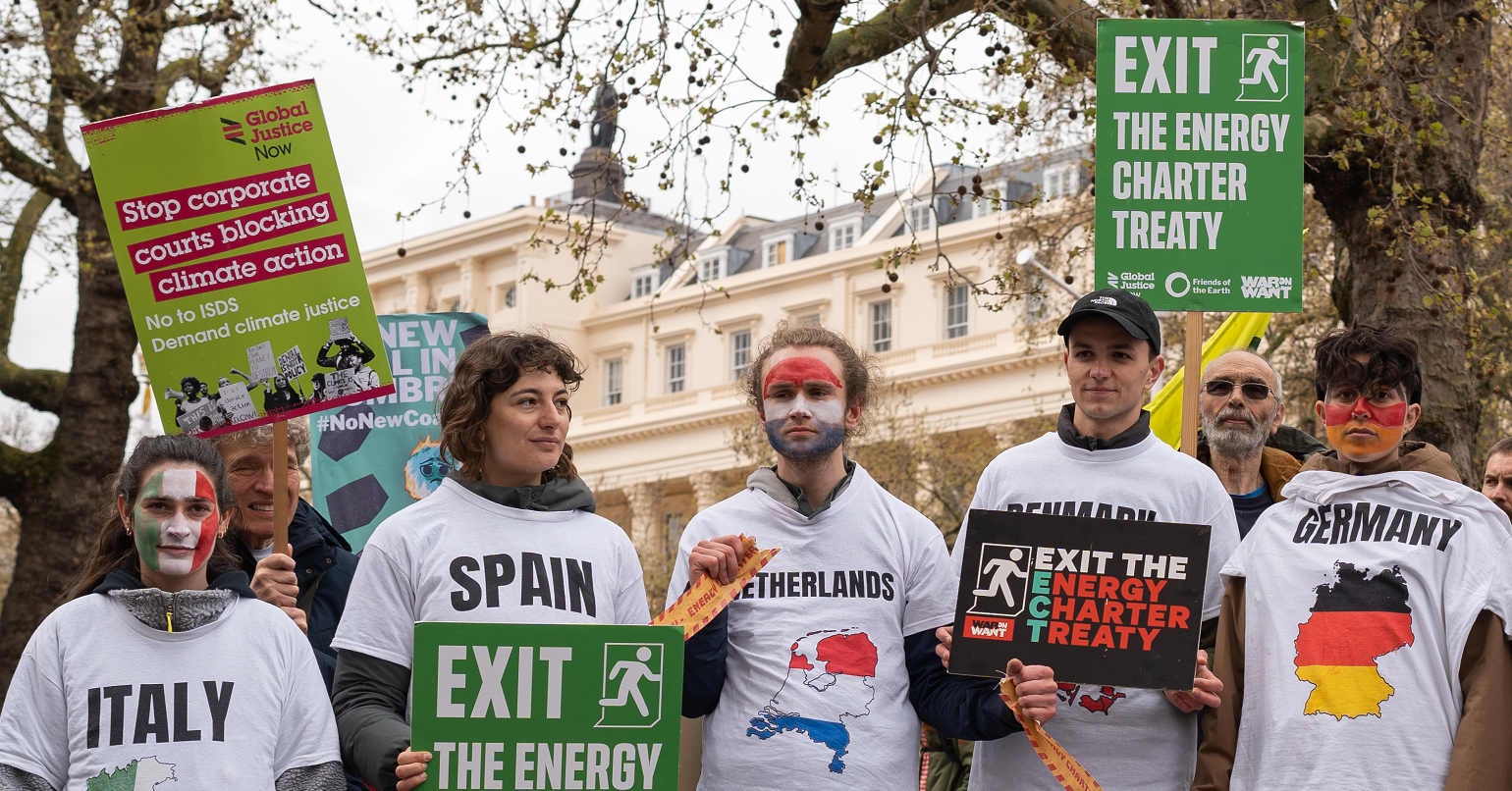Why Scotland should be worried about the Energy Charter Treaty

As the climate and biodiversity emergencies deepen, the pressure is rightly increasing on governments to take urgent action to move away from coal, oil and gas. At the same time however, the profits of the fossil fuel companies have been hitting new highs and their efforts to save themselves and their profits are getting more and more desperate.
One little known way that these companies can protect their profits is by using the Energy Charter Treaty to challenge action by governments on climate change – by suing them for lost profits (now and into the future). This treaty may be one that most of us have never heard of, but it’s the most significant single treaty threatening the transition to a zero carbon economy. That threat is as real in Scotland as anywhere else, and here we have the additional dimension that if a company were to challenge Scottish government policies or actions on climate change then it would be the UK government who would fight the case (as the party to the treaty) but the Scottish government who would pay the costs.
What is the Energy Charter Treaty?
The Energy Charter Treaty (ECT) is an investment agreement between 50 countries specifically for the energy sector. It dates back to the mid 1990s, from a time when the focus was on access to oil and gas reserves in countries of the former Soviet Union, and levels of climate ambition were not high. At the core of the ECT is the contentious investor state dispute settlement (ISDS) mechanism which allows foreign companies to sue governments outside of the national legal system in secretive tribunals for policy decisions that they believe will threaten their profits. The amounts at stake can be in the billions. The ECT has already generated at least 135 claims, making it the world’s most litigated ISDS agreement.
While many countries have realised this and are leaving the ECT, the UK government continues to keep us in the treaty, despite it having been estimated that the UK risks being sued for as much as $5.3 billion by fossil fuel corporations using it.
And while the UK remains a party to the ECT, that puts Scotland’s transition away from fossil fuels and efforts to protect biodiversity at risk as well. With decisions on the ECT currently being taken in both Europe and Westminster, the Scottish government needs to speak up for our interests here. And that means calling on the UK government to exit the treaty.
What might be at risk in Scotland?
The Scottish government’s recently published draft energy strategy and just transition plan suggests that it may oppose new onshore oil, gas and coal, and adopt a presumption against new oil and gas exploration in the North Sea (although it doesn’t give a timescale for this). There is clearly an urgent need for this to happen but it could be challenged by fossil fuel companies under the ECT which would allow them to sue for loss of future profits. That’s a huge threat to vital and necessary government action on climate change.
Then there’s the proposal from the Scottish government that 10% of Scotland’s seas be designated as Highly Protected Marine Areas (HPMA) by 2026. The consultation paper on Highly Protected Marine Areas states:
“It is intended that activities associated with oil and gas exploration, extraction and storage, including any exploratory activity and the construction of new infrastructure should be avoided within HPMAs. We will work with the UK Government to avoid, wherever possible, these activities taking place within a HPMA.”
While this proposal is still only at consultation stage, it is worth having an eye to the example of British oil company Rockhopper Exploration plc who successfully sued the Italian government under the Energy Charter Treaty for passing legislation to stop oil exploitation in Italian seas.
In 2016, due to public concerns about pollution, the Italian government reintroduced restrictions on oil and gas activity within 12 miles of its coast, the original restriction of 2010 having been repealed in 2012. Rockhopper then used the ECT to successfully claim more than £210million in compensation from the Italian Government over the cancellation of a new oilfield off the coast of Abruzzo. This amount was six times more than Rockhopper’s actual investment in the project, which is understood to have been around £33m.
And on the flip side of action to address the climate emergency, there’s the risk of the Energy Charter Treaty being used by other kinds of energy companies to sue governments too. And in this case it could be Scotland’s vast offshore wind energy resources that could be at risk.
Earlier this year, the results of the first round of offshore wind leasing (known as ScotWind) in Scottish waters for a decade were released. There are currently 20 ScotWind projects with seabed option agreements, with more expected in future leasing rounds. This first round of offshore wind leasing came under some criticism for not maximising income to the Scottish economy directly from leasing fees and also from supply chains. During the recent SNP leadership contest, First Minister Humza Yousaf is quoted as saying: “If I’m leader, for a future ScotWind round, I don’t think we should just lease, I think we should take an equity stake, so that if companies are benefiting, then that profit, that benefit is coming to us.” It’s perhaps understandable that, while making a big switch to renewable energy, policies and approaches may need to change and be adapted, but the ECT gives companies the ability to sue governments for these changes and to hamper much needed action to increase renewable energy.
We, and probably many others, would very much support the change in approach to offshore leasing described by Humza Yousaf, so that the public purse benefits more from Scotland’s renewable resources. But the experience of Spain shows that this kind of shift in policy could potentially be vulnerable to challenge under the ECT. Spain has been fighting cases brought under the ECT related to its renewable energy subsidy schemes for many years. Claims against it from investors are currently worth €2 billion.
So not only is Scottish Government action on moving away from fossil fuels at risk from the ECT but potentially also the move towards the massive scaling up of renewable energy that the climate crisis needs. What Scotland, and other countries, need is policy space to be able to experiment with ideas and get the climate transition right. The ECT is a straitjacket. The sooner we leave it the better.
All in all, it’s time to exit the ECT. And the Scottish government should call on the UK government to do just that.
You can also join thousands of citizens telling the UK government to exit the ECT.
Liz Murray is head of Scottish campaigns at Global Justice Now
PS. We hope you enjoyed this article. Bright Green has got big plans for the future to publish many more articles like this. You can help make that happen. Please donate to Bright Green now.
Image credit: Jonathan Salariya / Friends of the Earth EWNI – Creative Commons



Leave a Reply